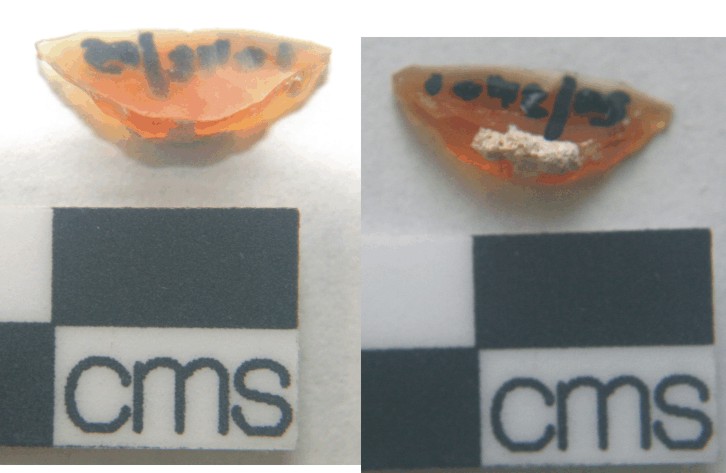AR503401-3402
{loadposition share}
AR50/3401
Stone arrowhead from Armant?

Types like this are usually considered lunate (crescent-shaped) arrowheads, though there is some debate as to whether they might not instead be sickle elements (see Honnegar 2008). Both transverse and bifacial flint arrowheads are found throughout the Dynastic Period, so, one might assume that this is what these are. Flint is lighter, sharper and more fragile than metal, all of which might make it better as a weapon, or hunting material than metal (Graves-Brown in press).
The example shown here is from Armant, from an A-Group burial excavated by Robert Mond. A fragement of travertine was found in the same burial. This is made from agate (cornelian). Agate is often used for A-Group lunates, and indeed is also used for Egyptian arrowheads. You can see the traces of mastic used to attach the flake to the haft.
Elements like this are used as arrowheads are known in throughout the Dynastic Period, for example, lunate agate arrowheads were found in the 1st Dynasty tomb of Hemaka (Emery and Saad 1938, 45–48). 2700 lunate and trapezoidal transverse arrowheads were found at the late Middle Kingdom-Early New Kingdom Egyptian fort of Mirgissa in Nubia (Vila 1970). Miller et al. (1986, 188) estimates that at this date the Egyptians could shoot 30 arrows every three minutes, which would explain the large numbers. Stone arrowheads comparable in date and form with the Mirgissa pieces come from the New Kingdom tombs of Tutankhamun (McLeod 1982, 24–25, 59), Mahirpir (Daressy 1902, 33–36, pl. 11), and Senenmut (Hayes 1959, 212), and from New Kingdom East Karnak (Miller 1985, 6, fig. 1.6). It is usually agreed that the Egyptians used stone arrowheads until late (e.g. Forbes 1966 VII, 108; Tillmann 1999; Hikade 2001. However, how late is debateable. Herodotus, Histories, Book III part II writing around 430 B.C., states that the Ethiopians used arrows tipped with stone ‘of the kind used in engraving seals’ rather than iron. This suggests that by this date it was unusual for societies to use stone tipped arrowheads (he tends to mention the unusual). However, there is some evidence that the Egyptians at least occasionally used stone arrowheads at this date.
Balfour (1897) and Hickman (1959) both describe 26th Dynasty arrows, now in the Pitt Rivers Museum (accession number 1896.2.1.16) as being chert tipped and as having a wide transverse cutting edge which is illustrated (a crescent shaped tip is shown in Balfour 1897, pl. 10). There are also similar dated examples from Theban tombs in Ashmolean (illustrated in Clarke et al. 1974, 350, pls. 12-13) which have microlithic tips and separate barbs.
The Egypt Centre has:
two stela belonging to bowman W1366 and EC62.
several Predynastic hollow-based arrowheads
Other material from Armant, including A-Group
References
Balfour, H. 1897, ‘On a Remarkable Bow and Arrows Believed to be of Assyrian Origin’. Journal of the Anthropological Institute, 26, 219-220.
Clark, J. D., Phillips, J. L. and Staley, P. S. 1974, ‘Interpretations of Prehistoric Technology from Ancient Egypt and Other Sources’. Paléorient, 2, 323-388.
Daressy, G. 1902, Fouilles de la Vallée des Rois (1898-1899). Cairo: Institut Française d’Archéologie Orientale du Caire.
Emery, W. B. and Saad, Z. Y. 1938, Excavations at Saqqara. The Tomb of Hemaka. Cairo: Government Press.
Forbes, R. J. 1966, Studies in Ancient Technology. Leiden: E. J. Brill.
Graves-Brown, C. in press. ‘Forts and Flint: The Role of Flint in Late Middle Kingdom-New Kingdom Egyptian Weaponry’, in Gill, D.W.J, Morris, E.F. and Mumford, G. (eds.), Walls of the Ruler: Fortifications, Police Beats, and Military Checkpoints in Ancient Egypt. Leiden: E. J. Brill.
Hayes, W. C. 1959, The Scepter of Egypt: A Background for the Study of the Egyptian Antiquities in the Metropolitan Museum of Art. (1675-1080 B.C.). New York: Metropolitan Museum of Art.
Hickman, C. N. 1959, ‘Ancient Composite Bows’, Journal of the Society of Archer Antiquaries, 2, 21-24.
Hikade, T., 2001, ‘Silex-Pfeilspitzen in Ägypten’. Mitteilungen des Deutschen Archäologischen Instituts Abteilung Kairo, 57, 109-125.
Honeggar, M. 2008. Lunate microliths in the holocene industries of Nubia: Multifunctional tools, sickle blades or weapon elements? In Projectile Weapon Elements from the Upper Palaeolithic to Neolithic (Proceedings of session C83, XVth World Congress UISPP, Lisbon September 4=9, 2006) P@lethnologie 2008.1 162-174.
McLeod, W. 1982, Self Bows and Other Archery Tackle from the Tomb of Tutankhamun. Oxford: Griffith Institute.
Miller, R. 1985, ‘Lithic Technology in East Karnak’. Journal of the Society for the Study of Egyptian Antiquities, 13, 228-236.
Miller, R. L., McEwen, E. and Bergman, C. 1986, ‘Experimental Approaches to Ancient Near Eastern Archery’. World Archaeology, 18(2), 178-195.
Tillmann, A. 1999, ‘Dynastic Stone Tools’, in Bard, K. A. (ed.), Encyclopedia of the Archaeology of Ancient Egypt, 262-265. London: Routledge.
Vila, A. 1970, ‘L’Armement de la Forteresse de Mirgissa-Iken’. Revue d’Égyptologie, 22, 170-199.